Digital and Traditional Learning: Learning Styles with Music and Technology for Early Childhood Education †
Abstract
1. Introduction
2. Early Childhood Music and Technology
2.1. Music Emotion
2.2. Blended Learning
2.3. Learning Styles (Visual, Auditory, Tactile)
2.4. Technology in Music Classroom
3. Hypothesis Development and Methodology
3.1. Research Question and Hypothesis
3.1.1. Research Question
3.1.2. Hypothesis
4. Result
4.1. Research Question 1: Independence t-Test
4.2. Hypothesis 1: Two-Way ANOVA Analysis
4.3. Hypothesis 2: Two-Way ANOVA Analysis
4.4. Hypothesis 3: Two-Way ANOVA Analysis
4.5. Hypothesis 4: Multiple Regression Analysis
4.6. Hypothesis 5: Multiple Regression Analysis
4.7. Reliability Anslysis
4.8. Factor Analysis and Construct Valisity
5. Conclusions
6. Limitation and Future Study
Author Contributions
Funding
Institutional Review Board Statement
Informed Consent Statement
Data Availability Statement
Conflicts of Interest
References
- Ogunnaike, Y.A. Early childhood education and human factor: Connecting theories and perspectives. Hum. Factor Stud. 2015, 21, 9–26. [Google Scholar]
- Son, H.L. Kindergarten Education, 2nd ed.; Taipei City Teachers College: Taipei, Taiwan, 1976. [Google Scholar]
- FNAE. National Core Curriculum for Early Childhood Education and Care 2018; Finnish National Agency for Education: Helsinki, Finland, 2018. [Google Scholar]
- Ruokone, I.; Tervaniemi, M.; Reunamo, C.J. The significance of music in early childhood education and care of toddlers in Finland: An extensive observational study. Music Educ. Res. 2021, 23, 634–646. [Google Scholar] [CrossRef]
- Virtala, P. The Neural Basis of Western Music Chord Categorisations—Effects on Development and Music Expertise. Ph.D. Thesis, Institute of Behavioural Sciences, University of Helsinki, Helsinki, Finland, 2015. [Google Scholar]
- Gerry, D.; Unrau, A.; Trainor, L.J. Active Music Classes in Infancy Enhance Musical, Communicative and Social Development. Dev. Sci. 2012, 15, 398–407. [Google Scholar] [CrossRef] [PubMed]
- Muhonen, S. Songcrafting: A Teacher’s Perspective of Collaborative Inquiry and Creation of Classroom Practice. Int. J. Music Educ. 2014, 32, 185–202. [Google Scholar] [CrossRef]
- Ozel, O. An Exploration of Turkish Kindergarten Early Career Stage Teachers’ Technology Beliefs and Practices. Ph.D. Thesis, University of Missouri, Colombia, MO, USA, 2019. [Google Scholar]
- Ko, M.Y. YouTube as an Early Childhood Music Education Resource: Parental Attitudes, Beliefs, Usages, and Experiences. Ph.D. Thesis, University of Missouri, Colombia, MO, USA, 2018. [Google Scholar]
- Kirkwood, D.; Shulsky, D.; Willis, J. Beyond pinatas, fortune cookies, and wooden shoes: Using the world wide web to help children explore the whole wide world. Child. Educ. 2014, 90, 11–19. [Google Scholar] [CrossRef]
- Kazakoff, E.; Bers, M. Programming in a robotics context in the kindergarten classroom: The impact on sequencing skills. J. Educ. Multimed. Hypermedia 2012, 21, 371–391. [Google Scholar]
- Rideout, V. The Common Sense Media Census: Media Use by Kids Age Zero to Eight. 2017. Available online: http://static1.1.sqspcdn.com/static/f/1083077/27723826/1508433603540/CSM_ZeroToEight_Full+Report.FINAL.2017.1.pdf?token=6XzqNxlxaFwyzQ3IB%2BSUeFKimk8%3D (accessed on 19 October 2017).
- Wartella, E.; Rideout, V.; Lauricella, A.R.; Connell, S.L. Parenting in the Age of Digital Technology. 2013. Available online: https://cmhd.northwestern.edu/wpcontent/uploads/2015/06/ParentingAgeDigitalTechnology (accessed on 4 June 2013).
- Palaiologou, I. Children under five and digital technologies: Implications for early years pedagogy. Eur. Early Child. Educ. Res. J. 2014, 24, 5–24. [Google Scholar] [CrossRef]
- Gordon, E. A Music Learning Theory for Newborn and Young Children; GIA Publications: Chicago, IL, USA, 2003. [Google Scholar]
- Mooney, C.G. Theories of Childhood: An introduction to Dewey, Montessori, Erikson, Piaget & Vygotsky, 2nd ed.; Redleaf Press: St Paul, MN, USA, 2013. [Google Scholar]
- Anderkin, D.M. An Analysis of Technology Integration within a Play-Based Learning Environment at the Preschool Level. Master’s Thesis, Cedarville University, Cedarville, OH, USA, 2015. Available online: http://digitalcommons.cedarville.edu/education_theses/7 (accessed on 15 August 2015).
- Jorgensen, R.L.; Logan, H. Computer use by preschool children: Rethinking practices as digital natives come to preschool. Aust. J. Early Child. 2015, 33, 37–44. [Google Scholar]
- Cameron, A.L.C. Opening Doors: A Collective Case Study of Integrating Technology in the Preschool through 3rd Grade Classroom in a Developmentally Appropriate Way. Ph.D. Thesis, Pepperdine University, Malibu, CA, USA, 2015. [Google Scholar]
- White, H.S. Early Childhood Teacher Perspectives of Developmentally Appropriate Use of Computer Applications. Ph.D. Thesis, Walden University, Minneapolis, MN, USA, 2015. [Google Scholar]
- Billington, C. How Digital Technology Can Support Early Language and Literacy Outcomes in Early Years Settings: A Review of the Literature; National Literacy Trust: London, UK, 2016. [Google Scholar]
- Sharkins, K.A.; Newton, A.B.; Albaiz, N.E.A.; Ernest, J.M. Preschool children’s exposure to media, technology, and screen time: Perspectives of caregivers from three early childcare settings. Early Child. Educ. J. 2016, 44, 437–444. [Google Scholar] [CrossRef]
- Marsh, J.; Brooks, G.; Hughes, J.; Ritchie, L.; Roberts, S.; Wright, K. Digital Beginnings: Young Children’s Use of Popular Culture, Media and New Technologies; University of Sheffield: Sheffield, UK, 2005. [Google Scholar]
- Huang, C.; Yu, K. Research on the innovation of college music teaching mode based on Artificial Intelligence. J. Phys. Conf. Ser. 2021, 1915, 022051. [Google Scholar] [CrossRef]
- Putkinen, V.; Tervaniemi, M.; Saarikivi, K.; Ojala, P.; Huotilainen, M. Enhanced development of auditory change detection in musically trained school-aged children: A longitudinal event-related potential study. Dev. Sci. 2014, 17, 282–297. [Google Scholar] [CrossRef]
- Marjanen, K. The Belly-Button Chord: Connections of Pre-and Postnatal Music Education with Early MotherChild Interaction. Ph.D. Thesis, Faculty of Humanities of the Universities of Jyväskylä, Jyväskylä, Finland, 2009. [Google Scholar]
- Davidson, R.; Scherer, K.; Goldsmith, H. The Handbook of Affective Sciences; Oxford University Press: Oxford, UK, 2003. [Google Scholar]
- Huang, S.; Zhou, L.; Liu, Z.; Ni, S.; He, J. Empirical research on a fuzzy model of music emotion classification based on pleasurearousal model. In Proceedings of the 2018 37th Chinese Control Conference, Wuhan, China, 25–27 July 2018; pp. 3239–3244. [Google Scholar]
- Fernandez, N.B.; Hars, M.; Trombetti, A.; Vuilleumier, P. Age-related changes in attention control and their relationship with gait performance in older adults with high risk of falls. Neuroimage 2019, 189, 551–559. [Google Scholar] [CrossRef]
- Balkwill, L.L.; Thompson, W.F. A cross-cultural investigation of the perception of emotion in music: Psychophysical and cultural cues. Music Percept. 1999, 17, 43–64. [Google Scholar] [CrossRef]
- Juslin, P.N.; Vastfjall, D. Emotional responses to music. The need to consider underlying mechanism. Behav. Brain Sci. 2008, 31, 559. [Google Scholar] [CrossRef]
- Sloboda, J.A. Music structure and emotional response: Some empirical findings. Psychol. Music 1991, 19, 110–120. [Google Scholar] [CrossRef]
- Behne, K.E. The Development of “Musikerleben” in Adolescence; Psychology Press: East Sussex, UK, 1997; pp. 143–159. [Google Scholar]
- Bonk, C.J.; Graham, C.R. The Handbook of Blended Learning: Global Perspectives, Local Designs; Pfieffer: Aßlar, Germany, 2013. [Google Scholar]
- Garrison, D.R.; Vaughans, N.D. Blended Learning in Higher Education: Framework, Principles, and Guidelines; John Wiley & Sons Inc.: Hoboken, NJ, USA, 2008. [Google Scholar]
- Motteram, G.; Sharma, P. Blending learning in a web 2.0 world. Int. J. Emerg. Technol. Soc. 2009, 7, 83–96. [Google Scholar]
- Hoffman, J.; Miner, N. Real blended learning stands up. Train. Dev. 2008, 62, 28–31. [Google Scholar]
- Graham, C.R. Blended Learning Systems: Definition, Current Trends, and Future Directions. In Handbook of Blended Learning: Global Perspectives, Local Designs; Bonk, C.J., Graham, C.R., Eds.; Pfeiffer Publishing: Zurich, Switzerland, 2006. [Google Scholar]
- Garrison, D.R.; Vaughan, N. Blended Learning in Higher Education; Jossey-Bass: Francisco, CA, USA, 2008. [Google Scholar]
- Frederique, B.; Ha, L.; Scott, M.; Clara, N.; Lilibeth, J. Defining student learning experience through blended learning. Educ. Inf. Technol. 2020, 25, 3049–3069. [Google Scholar]
- Hrastinski, S. Asynchronous & Synchronous E-Learning. Educ. Q. 2008, 31, 51–55. [Google Scholar]
- Divakaran, A. Enhancing Math learning using synchronous online teaching. J. Soc. Sci. 2015, 14, 27–36. [Google Scholar] [CrossRef]
- Dada, E.G.; Alkali, A.H. An investigation into the effectiveness of asynchronous and synchronous e-learning mode’s on students’ academic performance in National Open University (NOUN), Maiduguri Centre. Int. J. Mod. Educ. Comput. Sci. 2019, 5, 54–64. [Google Scholar] [CrossRef]
- Kolb, D. Experiential Learning: Experience and the Source of Learning and Development, 2nd ed.; Pearson Education: Harlow, UK, 2015. [Google Scholar]
- Keefe, J.W. Learning Style Theory and Practice; NASS: Reston, VA, USA, 1987. [Google Scholar]
- Felder, R.M.; Silverman, L.K.L. Learning and teaching styles in engineering education. Eng. Educ. 1988, 78, 674–681. [Google Scholar]
- Summers, E.S. The Effects of Parental Involvement and Computer-Based Music Technology on Developing Independent Musicianship. Ph.D. Thesis, Concordia University, Irvine, CA, USA, 2018. [Google Scholar]
- Sandy, R.J.; Murtiyasa, B. Developing a multimedia-based learning media for learning matrix transformation. J. Phys. Conf. Ser. 2019, 1265, 012020. [Google Scholar] [CrossRef]
- Burnard, P. Reframing creativity and technology: Promoting pedagogic change in music education. J. Music Technol. Educ. 2008, 1, 37–55. [Google Scholar] [CrossRef]
- Kuzmich, J. Technology is Essential to Accomplished Core Music Standards. Sch. Band Orch. 2015, 6, 48–50. Available online: http://www.kuzmich4.com/SBO%20Articles/August2015.pdf (accessed on 15 August 2015).
- Owen, S.L. Student Perceptions of the Efficacy of Smart Music Practice Software. Master’s Thesis, California State University, Long Beach, CA, USA, 2015. [Google Scholar]
- Wang, H. The application of computer music production technology in college music teaching. J. Qinghai Norm. Univ. 2015, 172, 132–136. [Google Scholar]
- Chen, J. Thoughts on the status quo of computer music in college music teaching. Contemp. Music 2016, 17, 2. [Google Scholar]
- Wang, L. Application of computer music technology in college music teaching. J. Phys. Conf. Ser. 2021, 1915, 032073. [Google Scholar] [CrossRef]
- Fishbein, M.; Ajzen, I. Belief, Attitude, Intention and Behavior: An Introduction to Theory and Research; Reading Addison-Wesley Publishing Co.: Boston, MA, USA, 1975. [Google Scholar]
- Abrahim, S.; Mir, B.A.; Suhara, H.; Mohamed, F.A.; Sato, M. Structural equation modeling and confirmatory factor analysis of social media use and education. Int. J. Educ. Technol. High. Educ. 2019, 16, 32. [Google Scholar] [CrossRef]
- Dumpit, D.Z.; Fernandez, C.J. Analysis of the use of social media in Higher Education Institutions (HEIs) using the Technology Acceptance Model. Int. J. Educ. Technol. High. Educ. 2017, 14, 5. [Google Scholar] [CrossRef]
- Yu, L.; Ding, J. Application of Music Artificial Intelligence in Preschool Music Education. IOP Conf. Ser. Mater. Sci. Eng. 2020, 750, 012101. [Google Scholar] [CrossRef]
- Lei, D. Research on network teaching of music major based on artificial intelligence technology. J. Phys. Conf. Ser. 2020, 1648, 042094. [Google Scholar] [CrossRef]
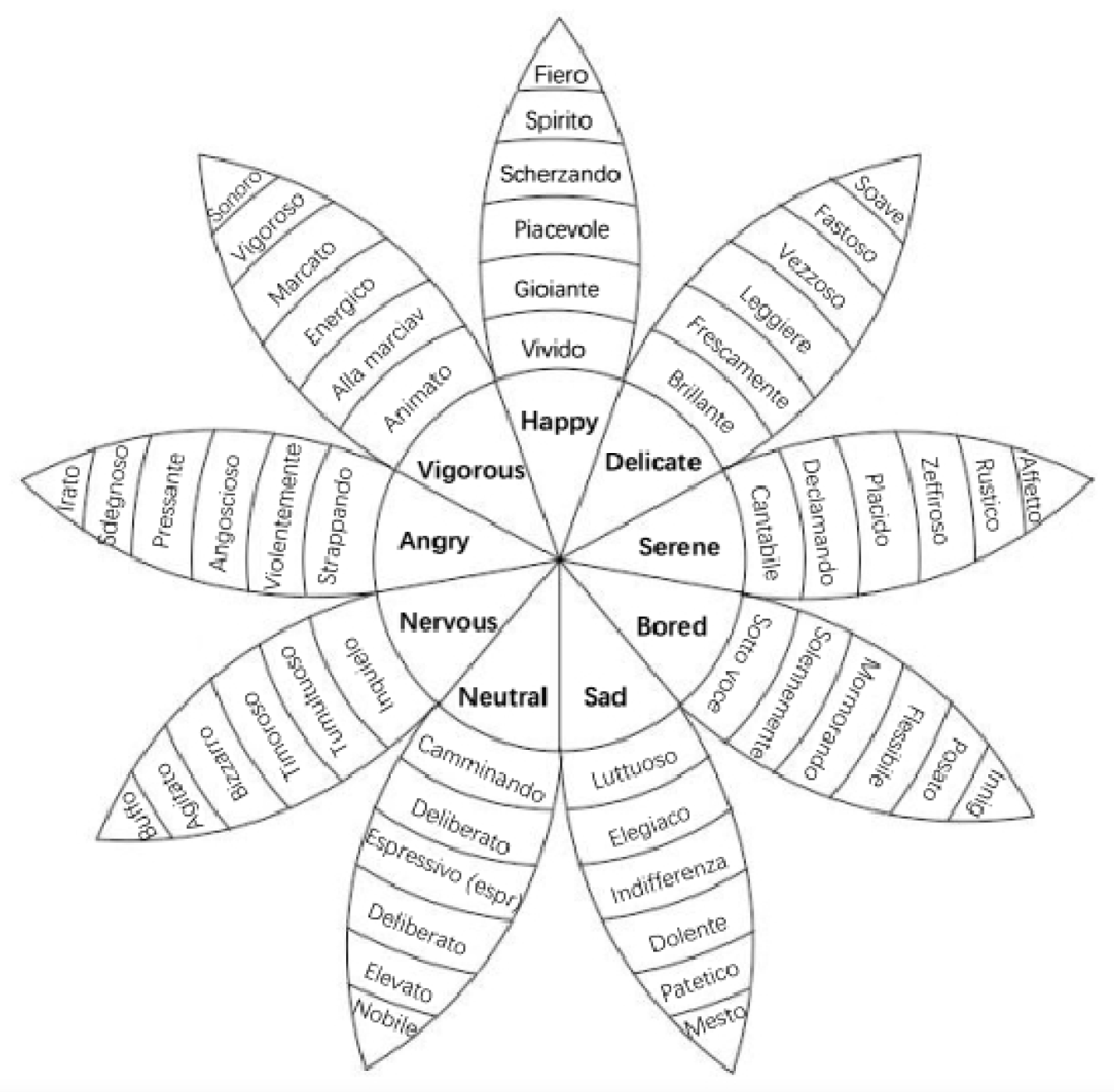
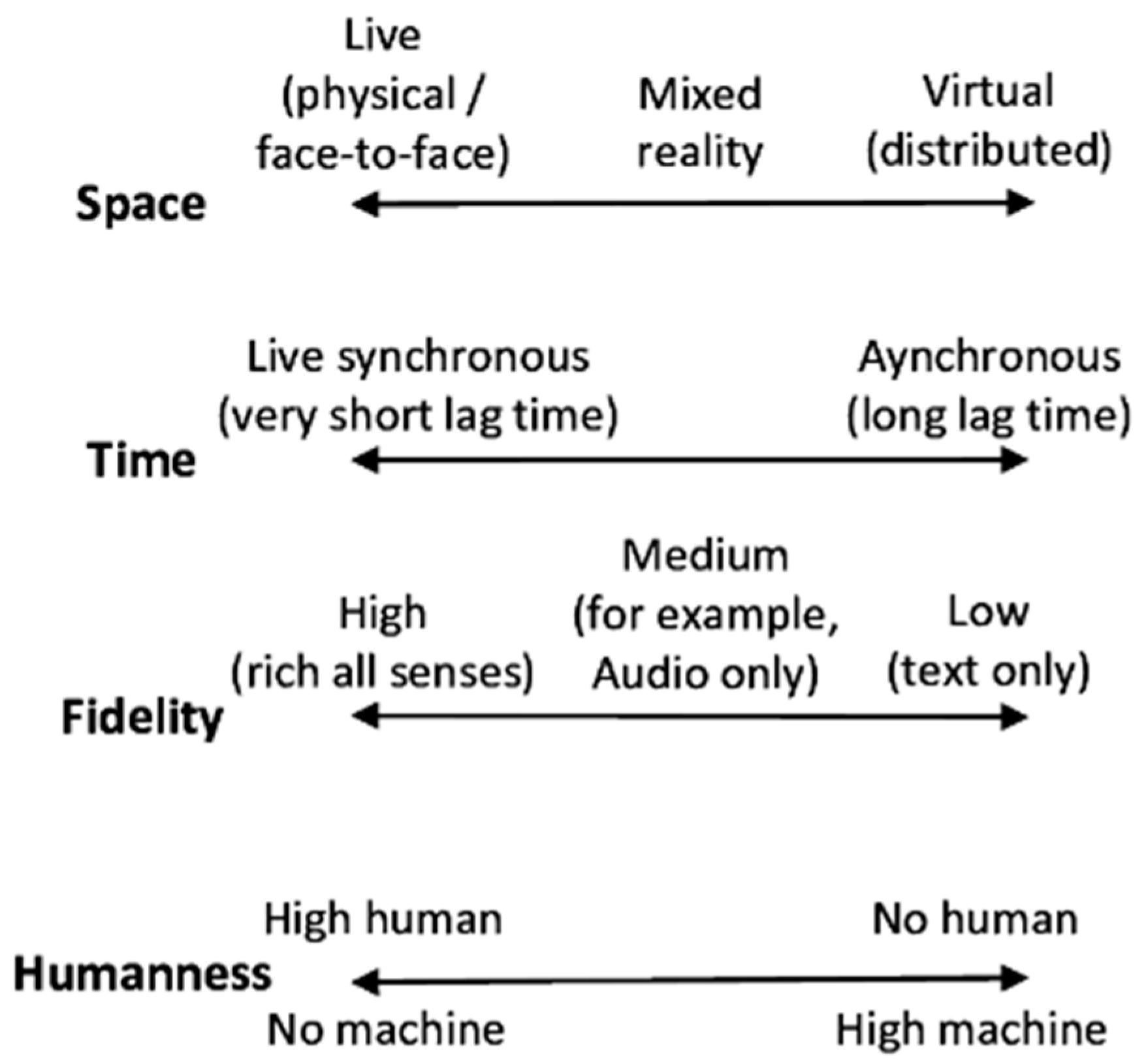
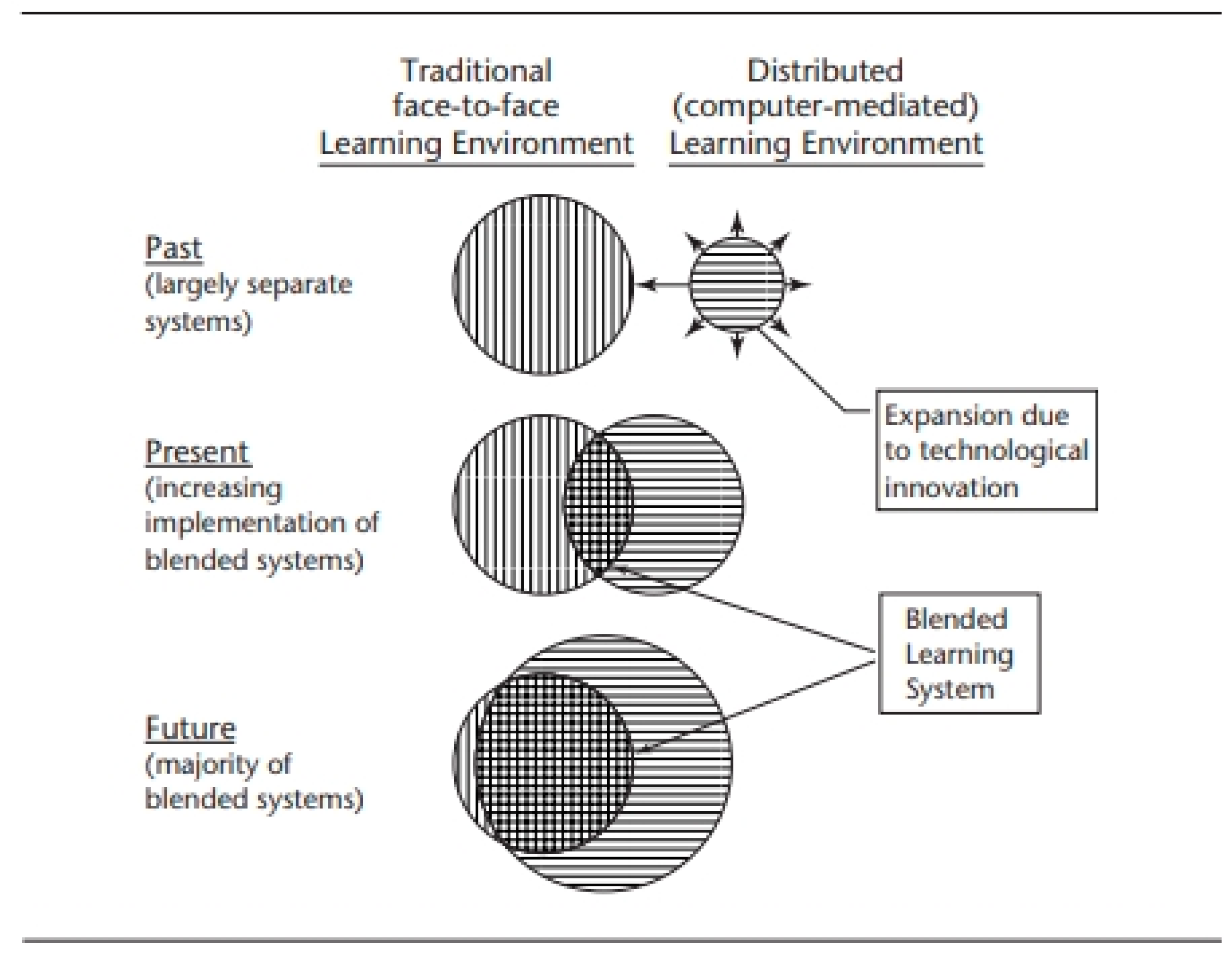

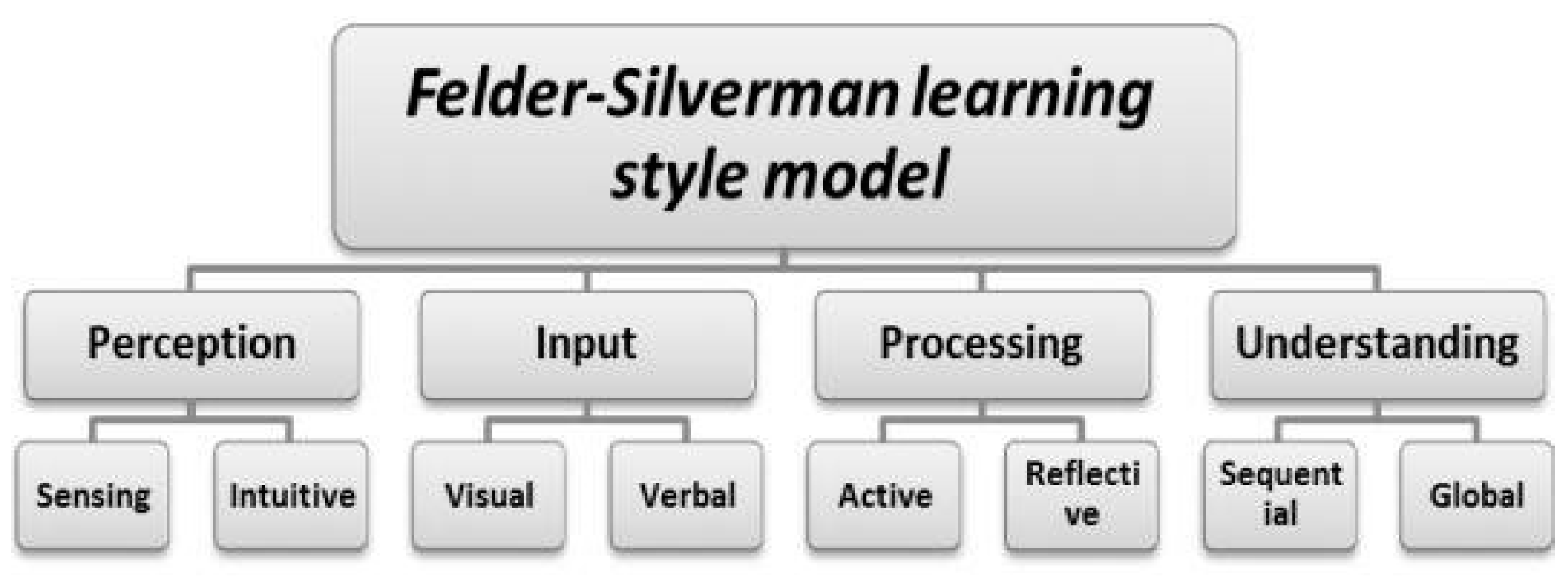

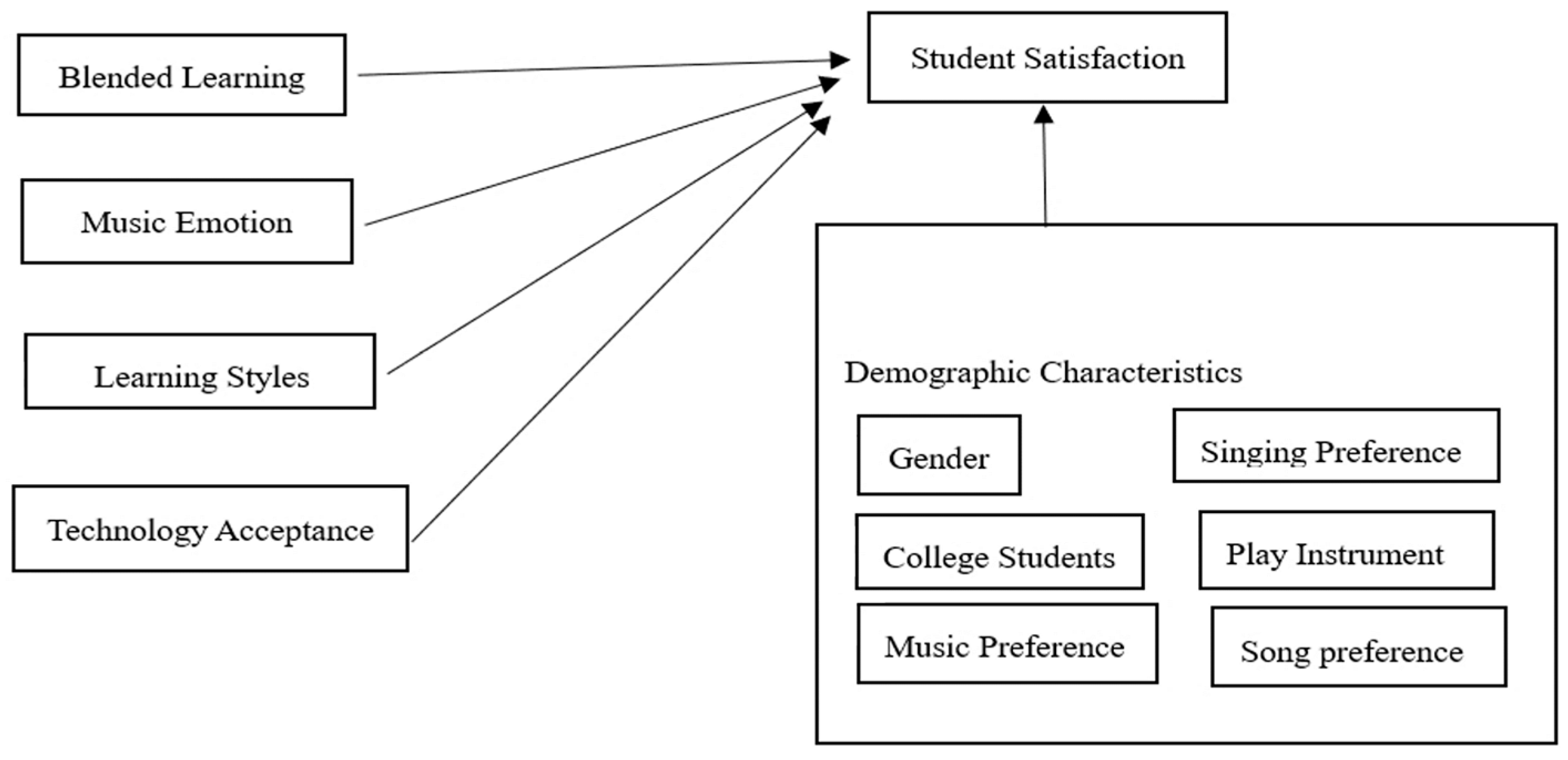
| F | Sig. | t | df | Sig. (Two-Tailed) | |
|---|---|---|---|---|---|
| Blended Learning | 2.624 | 0.106 | 2.437 | 292 | 0.015 |
| 2.377 | 241.601 | 0.018 | |||
| Music Emotion | 1.824 | 0.178 | 1.316 | 292 | 0.189 |
| 1.328 | 277.742 | 0.185 | |||
| Learning Styles | 2.793 | 0.096 | 3.578 | 292 | 0.000 |
| 3.527 | 253.723 | 0.000 | |||
| Technology Acceptance | 0.034 | 0.853 | 2.109 | 292 | 0.036 |
| 2.115 | 272.276 | 0.035 | |||
| Student Satisfaction | 1.713 | 0.192 | 2.286 | 292 | 0.023 |
| 2.243 | 248.270 | 0.026 |
| Source | Type III Sum of Squares | df | Mean Square | F | Sig. |
|---|---|---|---|---|---|
| Corrected Model | 41.136 | 126 | 0.326 | 2.284 | 0.000 |
| Intercept | 962.793 | 1 | 962.793 | 6735.689 | 0.000 |
| Blended Learning | 6.061 | 14 | 0.433 | 3.029 | 0.000 |
| Learning Styles | 8.248 | 23 | 0.359 | 2.509 | 0.000 |
| Blended learning Learning styles | 10.789 | 89 | 0.121 | 0.848 | 0.805 |
| Source | Type III Sum of Squares | df | Mean Square | F | Sig. |
|---|---|---|---|---|---|
| Corrected Model | 59.174 | 235 | 0.252 | 2.504 | 0.000 |
| Intercept | 1668.748 | 1 | 1668.748 | 16,595.412 | 0.000 |
| Music Emotion | 17.357 | 82 | 0.212 | 2.105 | 0.002 |
| Learning Styles | 8.478 | 23 | 0.369 | 3.666 | 0.000 |
| Music Emotion Learning Styles | 17.369 | 130 | 0.134 | 1.329 | 0.112 |
| Source | Type III Sum of Squares | df | Mean Square | F | Sig. |
|---|---|---|---|---|---|
| Corrected Model | 46.145 | 122 | 0.378 | 3.429 | 0.000 |
| Intercept | 983.089 | 1 | 983.089 | 8913.021 | 0.000 |
| Technology Acceptance | 7.094 | 13 | 0.546 | 4.948 | 0.000 |
| Learning Styles | 4.759 | 23 | 0.207 | 1.876 | 0.013 |
| Technology Acceptance Learning Styles | 11.461 | 86 | 0.133 | 1.208 | 0.149 |
| Model | Sum of Squares | df | Mean Square | F | Sig. |
|---|---|---|---|---|---|
| Regression | 0.166 | 5 | 0.033 | 1.678 | 0.140 |
| Residual | 5.711 | 288 | 0.020 | ||
| Total | 5.878 | 293 |
| Model | Sum of Squares | df | Mean Square | F | Sig. | |
|---|---|---|---|---|---|---|
| 1 | Regression | 3.461 | 5 | 0.692 | 2.909 | 0.014 |
| Residual | 68.539 | 288 | 0.238 | |||
| Total | 72.000 | 293 | ||||
| Cronbach’s Alpha | Cronbach’s Alpha Based on Standardized Items | N of Items |
|---|---|---|
| 0.876 | 0.879 | 57 |
| Kaiser–Meyer–Olkin Measure of Sampling Adequacy | 0.785 | |
| Bartlett’s Test of Sphericity | Approx. Chi-Squared | 550.467 |
| df | 10 | |
| Sig. | 0.000 | |
| Component | Initial Eigenvalues | Extraction Sums of Squared Loadings | ||||
|---|---|---|---|---|---|---|
| Total | % of Variance | Cumulative % | Total | % of Variance | Cumulative % | |
| 1 | 2.902 | 58.037 | 58.037 | 2.902 | 58.037 | |
| 2 | 0.883 | 17.657 | 75.694 | 58.037 | ||
| 3 | 0.549 | 10.971 | 86.666 | |||
| 4 | 0.398 | 7.957 | 94.622 | |||
| 5 | 0.269 | 5.378 | 100.000 | |||
Disclaimer/Publisher’s Note: The statements, opinions and data contained in all publications are solely those of the individual author(s) and contributor(s) and not of MDPI and/or the editor(s). MDPI and/or the editor(s) disclaim responsibility for any injury to people or property resulting from any ideas, methods, instructions or products referred to in the content. |
© 2023 by the authors. Licensee MDPI, Basel, Switzerland. This article is an open access article distributed under the terms and conditions of the Creative Commons Attribution (CC BY) license (https://creativecommons.org/licenses/by/4.0/).
Share and Cite
Lee, L.; Lin, C.-H. Digital and Traditional Learning: Learning Styles with Music and Technology for Early Childhood Education. Eng. Proc. 2023, 38, 19. https://doi.org/10.3390/engproc2023038019
Lee L, Lin C-H. Digital and Traditional Learning: Learning Styles with Music and Technology for Early Childhood Education. Engineering Proceedings. 2023; 38(1):19. https://doi.org/10.3390/engproc2023038019
Chicago/Turabian StyleLee, Liza, and Chia-Hui Lin. 2023. "Digital and Traditional Learning: Learning Styles with Music and Technology for Early Childhood Education" Engineering Proceedings 38, no. 1: 19. https://doi.org/10.3390/engproc2023038019
APA StyleLee, L., & Lin, C.-H. (2023). Digital and Traditional Learning: Learning Styles with Music and Technology for Early Childhood Education. Engineering Proceedings, 38(1), 19. https://doi.org/10.3390/engproc2023038019







